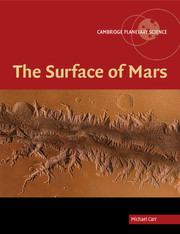6 - Channels, valleys, and gullies
Published online by Cambridge University Press: 12 August 2009
Summary
The discovery of seemingly water-worn valleys during the Mariner 9 mission remains one of the most transforming events in the history of our exploration of the Solar System. Our perception of Mars as a dry, cold, sterile planet was changed forever to that of a planet that likely had experienced warm and wet surface conditions under which life could have originated and survived. When the channels and valleys were first observed, there was considerable resistance to accepting them as water-worn because of the cold conditions that prevail on Mars today. Several alternative origins were proposed, including erosion by lava, hydrocarbons, and liquid CO2, glaciation, and mobilization of the surface materials as debris flows. However, the close resemblance of the channels and valleys to terrestrial water-worn features, the abundant presence of water ice, the finding of evaporites in Meridiani Planum and elsewhere, and the difficulties with other erosive agents, make it almost certain that the principal erosive agent that cut most of the channels and valleys was liquid water. While liquid water is likely the main agent, the source of the water and the conditions under which the channels and valleys formed are still controversial. In this chapter we explore how the channels and valleys formed and what they might imply about the abundance of water and past conditions on the planet. Climate history is discussed more fully in Chapter 12.
Valley is a general term used to describe any linear depression.
- Type
- Chapter
- Information
- The Surface of Mars , pp. 113 - 148Publisher: Cambridge University PressPrint publication year: 2007

